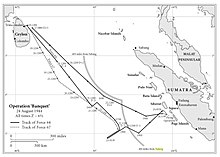Operation Banquet (Padang)
| Operation Banquet | |||||||
|---|---|---|---|---|---|---|---|
| Part of the Pacific Theatre of the Second World War | |||||||
 Operation Banquet | |||||||
| |||||||
| Belligerents | |||||||
|
|
| ||||||
| Commanders and leaders | |||||||
|
|
| ||||||
| Strength | |||||||
|
20–32 bombers 19–31 fighters 2 aircraft carriers 1 battleship 2 cruisers 5 destroyers 1 submarine | Anti-aircraft defences | ||||||
| Casualties and losses | |||||||
| 1 fighter destroyed | Ground targets damaged | ||||||
Operation Banquet was a British naval operation in the Second World War, commanded by Rear Admiral Clement Moody. The objective was to bomb Japanese positions in and around Padang, on the south-western coast of Sumatra, in Indonesia, on 24 August 1944.[1] The primary targets of the attack, Padang airfield, the Indaroeng cement works, and the harbor facilities and shipping at Emmahaven were hit.[2][3]
Background
Force 64
Ships involved in the operation included the aircraft carriers HMS Victorious and Indomitable; the battleship HMS Howe, two cruisers, including HMS Cumberland, five destroyers and a submarine.[1][4] Indomitable was carrying 28 F6F Hellcat fighters under Lieutenant Commander T. G. C. Jameson and 28 Fairey Barracuda bombers under Lieutenant Commander E. M. Britten. Many of the pilots were inexperienced and the British hoped that the mission would provide some additional training for them.[5]
Plan
The plan was to attack Padang airfield, Emmahaven harbour and the Indaroeng cement works. The cement works was the only factory of its kind in South-East Asia. If it was destroyed, the Japanese would be unable to construct fortifications or new buildings in the region.[5] The raid was also supposed to divert the Japanese from the American landings of the Battle of Hollandia and the Landing at Aitape. Reconnaissance photographs were also to be taken.[6]
Prelude
The force set out from Trincomalee on 19 August, delaying for 24 hours so the submarine HMS Sea Rover could replace Severn, which was experiencing technical difficulties. The cruisers and destroyers refuelled on 23 August from the replenishment oiler Easedale.[7]
Operation
The force arrived at its position at 05:00 on 24 August. There was a light wind coming from the south-east, so the carriers had to launch while steaming at 27 kn (50 km/h; 31 mph). Howe could not keep up and temporarily fell out of formation. The first wave consisted of twenty Barracudas (ten from each carrier) with 500 lb (230 kg) bombs and an escort of 19 Vought F4U Corsairs. The second wave launched at 07:10, consisting of twelve Barracudas (nine from Indomitable, 3 from Victorious) with an escort of twelve Corsairs (from Victorious).[5] The port and the airfield were never used by the Japanese, and as such there little was allotted to defend them. There was no air opposition and the bombing was accurate. One Corsair was shot down by light anti-aircraft fire.[5]
Aftermath
In spite of the accurate bombing, the targets proved to be of little strategic value. The new pilots did not gain much experience either, since they encountered only negligible opposition. The Japanese were not induced to divert resources from the Americans at Hollandia (now Jayapura) in New Guinea, according to the post-war testimony of Lieutenant-General Numata Takazo, the former chief of staff of the Southern Expeditionary Army Group.[6] The only notable success was the aerial photography from the Wildcats, which yielded excellent results.[5] The operation "marked the first time the British used a two-wave attack by two fleet carriers".[8] It came as an unpleasant surprise to the British that the brand new Howe, designed to achieve speeds of 28 kn (52 km/h; 32 mph), could not keep pace with the carriers at 27 kn (50 km/h; 31 mph). In spite of the relatively small distance covered, Victorious consumed about a quarter of her fuel.[5]
References
- ^ a b Rohwer & Hümmelchen 2005, p. 359.
- ^ Sturtivant 1990, pp. 124–125.
- ^ McCart 1998, p. 66.
- ^ Whitley 1998, p. 149.
- ^ a b c d e f Hobbs 2012, pp. 52–54.
- ^ a b MoD 1995, p. 216.
- ^ MoD 1995, p. 217.
- ^ Willmott 1996, p. 150.
Bibliography
- Hobbs, David (2012). The British Pacific Fleet: The Royal Navy's Most Powerful Strike Force (2nd ed.). Seaforth. ISBN 978-1-78346-922-2.
- McCart, Neil (1998). HMS Victorious, 1937–1969. Cheltenham: Fan. ISBN 978-1-901225-01-3.
- Rohwer, Jürgen; Hümmelchen, Gerhard (2005) [1972]. Chronology of the War at Sea, 1939–1945: The Naval History of World War Two (3rd rev. ed.). London: Chatham. ISBN 978-1-86176-257-3.
- Sturtivant, Ray (1990). British Naval Aviation: The Fleet Air Arm, 1917–1990. Annapolis, MD: Naval Institute Press. ISBN 0-87021-026-2.
- War with Japan: The Advance to Japan. Vol. VI. London: HMSO (Ministry of Defence Naval Historical Branch). 1995. ISBN 0-11-772821-7.
- Whitley, M. J. (1998). Battleships of World War Two: An International Encyclopaedia. Annapolis, MD: Naval Institute Press. ISBN 978-1-55750-184-4.
- Willmott, H. P. (1996). Grave of a Dozen Schemes: British Naval Planning and the War Against Japan, 1943–1945. Annapolis, MD: Naval Institute Press. ISBN 978-1-55750-916-1.
